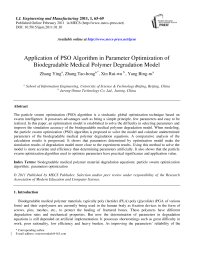Application of PSO Algorithm in Parameter Optimization of Biodegradable Medical Polymer Degradation Model
Автор: Zhang Ying, Zhang Tao-hong, Xin Rui-wu , Yang Bing-ru
Журнал: International Journal of Engineering and Manufacturing(IJEM) @ijem
Статья в выпуске: 1 vol.1, 2011 года.
Бесплатный доступ
The particle swarm optimization (PSO) algorithm is a stochastic global optimization technique based on swarm intelligence. It possesses advantages such as being a simple principle, few parameters and easy to be realized. In this paper, an optimization model is established to solve the difficulty in selecting parameters and improve the simulation accuracy of the biodegradable medical polymer degradation model. When modeling, the particle swarm optimization (PSO) algorithm is proposed to solve the model and calculate undetermined parameters of the biodegradable medical polymer degradation equations. A comparative analysis of the calculation results is progressed. It shows that parameters determined by optimization model make the simulation results of degradation model more close to the experiment results. Using this method to solve the model is more accurate and efficiency than determining parameters artificially. It also shows that the particle swarm optimization algorithm used to optimize parameters have practical significance and application value.
Biodegradable medical polymer material degradation equations, particle swarm optimization algorithm, parameters optimization
Короткий адрес: https://sciup.org/15014110
IDR: 15014110
Список литературы Application of PSO Algorithm in Parameter Optimization of Biodegradable Medical Polymer Degradation Model
- Siepmann J, Peppas NA, “Modelling of drug release from delivery systems based on hydroxypropyl methylcellulose (HPMC),” in Advanced Drug Delivery Reviews, vol. 48, 2001, pp. 139–57.
- Joshi A, Himmelstein KJ, “Dynamics of controlled release from bioerodible matrices ,” in Journal of Controlled Release, vol. 15, 1991, pp. 95–104.
- Zygourakis K, Markenscoff PA, “Computer-aided design of bioerodible devices with optimal release characteristics: a cellular automata approach, ” in Biomaterials, vol. 17, 1996, pp. 125–35.
- Göpferich A, Langer R, “Modelling monomer release from bioerodible polymers ,” in Journal of Controlled Release, vol. 33, 1995, pp. 55–69.
- Siepmann J, Siepmann F, Florence AT, “ Local controlled drug delivery to the brain: mathematical modelling of the underlying mass transport mechanisms ,” in International Journal of Pharmaceutics, 2006, pp. 101–19.
- Yu Ruixia, CHEN Hualing, Chen Tianning, “CA-based biodegradable drug delivery system modeling and simulation, ” in System Simulation, 2007, pp. 183-186. (in Chinese)
- Wang Xiaopeng, Chen Tianning, Yang Zhanxiao, “Monte Carlo model based on micro-PLGA delivery systems modeling and simulation, ” in Actuators, vol. 19, 2006, pp. 1327-1329. (in Chinese)
- Wang Y, Pan JZ, Han XX, Csaba Sinka, Lifeng Ding, “A phenomenological model for the degradation of biodegradable polymersin,” in Biomaterials, vol. 29, 2008, pp. 3393-3401.
- Han XX, Pan JZ, “A model for simultaneous crystallisation and biodegradation of biodegradable polymers, ” in Biomaterials, vol. 30, 2009, pp. 423-430.
- Kennedy J., Eberhart R.C., “Particle Swarm Optimization,” Proceedings of the 1995 IEEE International Conference on Neural Networks,Piscataway, NJ,Perth,Australia: IEEE service center, 1995, pp. 1942-1948.
- Eberhart R.C., Kennedy J, “A new optimizer using Particle Swarm Theory, ” Proceedings of the Sixth International Symposium on Micro Machine and Human Science, Nagoya, Japan, 1995, pp. 39-43.
- Grizzi I, Garreau H, Li S, Vert M, “Hydrolytic degradation of devices based on poly[DL- lactic acid] size dependence,” in Biomaterials, vol. 16, 1995, pp. 305-311.


